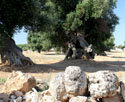Lecce Baroque
The Baroque and its decorative fascination
In 1539 emperor Carlo V chooses the city of Lecce as the chief town of Apulia making it a real building yard. The city is enlarged and completely renewed according to a more rational urban planning. This prosperous period is deeply linked with the famous architectural phenomenon called the Baroque of Lecce. It develops during the second half of the 17th century all over the Salento.
Fantasy and exuberance carved in the rocks

Fantasy and exuberance arise from the employment of the local stone, a limestone easy to be carved giving life to fruits, leaves, garlands, cherubims and animals. The city became increasingly rich of new palaces and religious and laic buildings to symbolize the power of both the aristocracy and the rich middle class. This deep renovation was particularly wanted by the holy orders of the city, such as the Jesuits and the Teatins. In most cases, all over the rest of the peninsula, the Baroque period has been characterized by the employment of travertine, stuccoes, frescoes and precious marbles; on the other hand, the main centres of the zone have been marked by the use of the tender local carparo, that takes the most eccentric and original forms thanks to the craftsmen’s mastery.

The most important authors of this renovation, who have been protagonists of it for almost two centuries, were: Giovanni Tarantino, Gabriele Riccardi, Francesco Anatonio and Giuseppe Zimbalo, Cesare Penna, Giuseppe Cino and Emanuele Manieri. It is also worth mentioning some important painters and decorators such as Gianserio Strafela, Oronzo Tiso and Antonio Verrio, who realized many pictures for the cathedral of Lecce and the church dedicated to Santa Irene, before becoming the official painter of Carlo II, king of England.

The most important evidences of the Baroque of Lecce are the Basilica of Santa Croce and the scenographic square dedicated to Sant’Oronzo, where you can admire the cathedral, the Bishop’s palace and the palace of the Seminary: here you can see a beautiful well richly decorated by Giuseppe Cino. It is also worth mentioning the churches dedicated to Santa Irene, Santa Chiara, San Matteo, San Giovanni Battista and the church of the Carmine.

 Home PUGLIA
Home PUGLIA Places to visit
Places to visit Sea places
Sea places Ancient villages
Ancient villages Salento
Salento Gargano
Gargano Tremiti Islands
Tremiti Islands Valle D'Itria
Valle D'Itria Lecce Baroque
Lecce Baroque Holy sites
Holy sites Olive groves
Olive groves Sitemap
Sitemap




